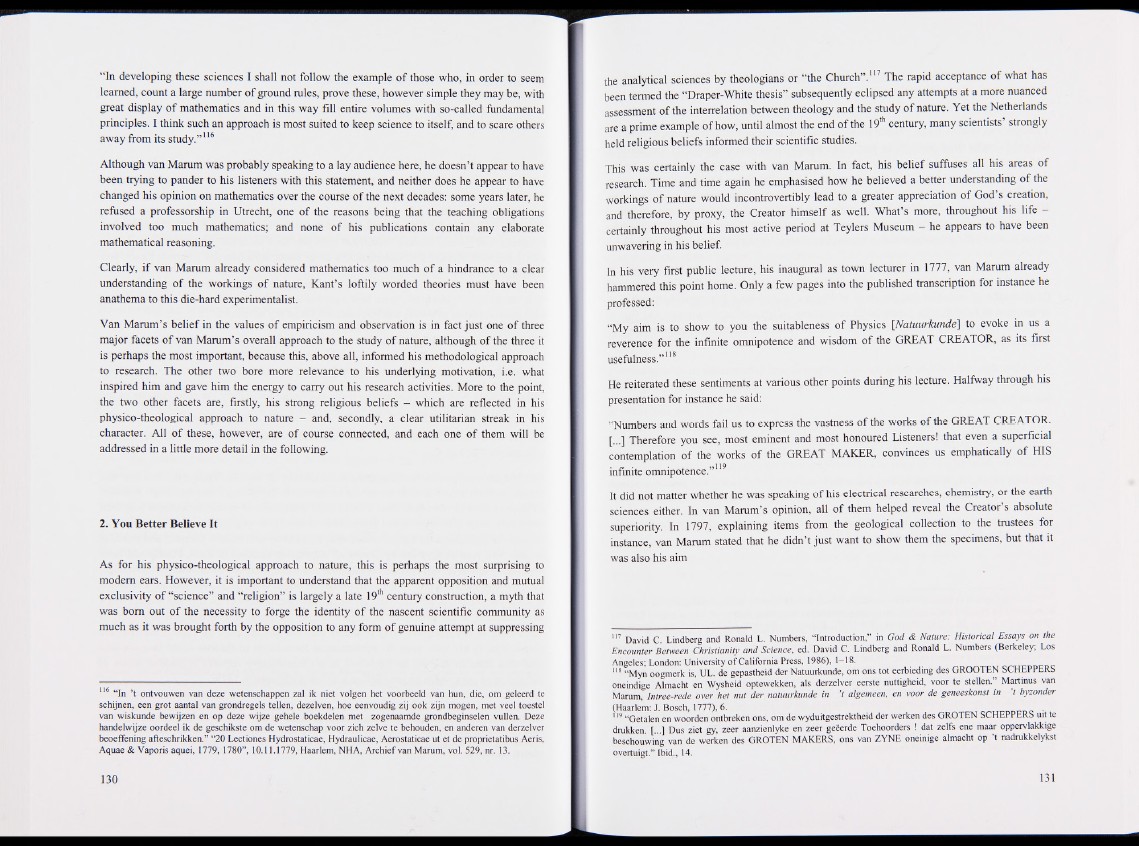
“In developing these sciences I shall not follow the example of those who, in order to seem
learned, count a large number of ground rules, prove these, however simple they may be, with
great display of mathematics and in this way fill entire volumes with so-called fundamental
principles. I think such an approach is most suited to keep science to itself, and to scare others
away from its study.”1
Although van Marum was probably speaking to a lay audience here, he doesn’t appear to have
been trying to pander to his listeners with this statement, and neither does he appear to have
changed his opinion on mathematics over the course of the next decades: some years later, he
refused a professorship in Utrecht, one of the reasons being that the teaching obligations
involved too much mathematics; and none of his publications contain any elaborate
mathematical reasoning.
Clearly, if van Marum already considered mathematics too much of a hindrance to a clear
understanding of the workings of nature, Kant’s loftily worded theories must have been
anathema to this die-hard experimentalist.
Van Marum’s belief in the values of empiricism and observation is in fact just one of three
major facets of van Marum’s overall approach to the study of nature, although of the three it
is perhaps the most important, because this, above all, informed his methodological approach
to research. The other two bore more relevance to his underlying motivation, i.e. what
inspired him and gave him the energy to carry out his research activities. More to the point,
the two other facets are, firstly, his strong religious beliefs - which are reflected in his
physico-theological approach to nature - and, secondly, a clear utilitarian streak in his
character. All of these, however, are of course connected, and each one of them will be
addressed in a little more detail in the following.
2. You Better Believe It
As for his physico-theological approach to nature, this is perhaps the most surprising to
modem ears. However, it is important to understand that the apparent opposition and mutual
exclusivity of “science” and “religion” is largely a late 191 century construction, a myth that
was bom out of the necessity to forge the identity of the nascent scientific community as
much as it was brought forth by the opposition to any form of genuine attempt at suppressing
11 “I n ’t ontvouwen van deze wetenschappen zal ik niet volgen het voorbeeld van hun, die, om geleerd te
schijnen, een grot aantal van grondregels teilen, dezelven, hoe eenvoudig zij ook zijn mögen, met veel toestel
van wiskunde bewijzen en op deze wijze gehele boekdelen met zogenaamde grondbeginselen vullen. Deze
handelwijze oordeel ik de geschikste om de wetenschap voor zieh zelve te behouden, en anderen van derzelver
beoeffening afteschrikken.” “20 Lectiones Hydrostaticae, Hydraulicae, Aerostaticae ut et de proprietatibus Aeris,
Aquae & Vaporis aquei, 1779, 1780”, 10.11.1779, Haarlem, NHA, Archief van Marum, vol. 529, nr. 13.
the analytical sciences by theologians or “the Church”. The rapid acceptance of what has
been termed the “Draper-White thesis” subsequently eclipsed any attempts at a more nuanced
assessment of the interrelation between theology and the study of nature. Yet the Netherlands
are a prime example of how, until almost the end of the 19th century, many scientists’ strongly
held religious beliefs informed their scientific studies.
This was certainly the case with van Marum. In fact, his belief suffuses all his areas of
research. Time and time again he emphasised how he believed a better understanding of the
workings of nature would incontrovertibly lead to a greater appreciation of God’s creation,
and therefore, by proxy, the Creator himself as well. What’s more, throughout his life -
certainly throughout his most active period at Teylers Museum — he appears to have been
unwavering in his belief.
In his very first public lecture, his inaugural as town lecturer in 1777, van Marum already
hammered this point home. Only a few pages into the published transcription for instance he
professed:
“My aim is to show to you the suitableness of Physics [Natuurkunde] to evoke in us a
reverence for the infinite omnipotence and wisdom of the GREAT CREATOR, as its first
usefulness.”118
He reiterated these sentiments at various other points during his lecture. Halfway through his
presentation for instance he said:
“Numbers and words fail us to express the vastness of the works of the GREAT CREATOR.
[...] Therefore you see, most eminent and most honoured Listeners! that even a superficial
contemplation of the works of the GREAT MAKER, convinces us emphatically of HIS
infinite omnipotence.”119
It did not matter whether he was speaking of his electrical researches, chemistry, or the earth
sciences either. In van Marum’s opinion, all of them helped reveal the Creator’s absolute
superiority. In 1797, explaining items from the geological collection to the trustees for
instance, van Marum stated that he didn’t just want to show them the specimens, but that it
was also his aim
117 David C. Lindberg and Ronald L. Numbers, “Introduction,” in God & Nature: Historical Essays on the
Encounter Between Christianity and Science, ed. David C. Lindberg and Ronald L. Numbers (Berkeley; Los
Angeles; London: University o f California Press, 1986), 1-18.
118 “Myn oogmerk is, UL. de gepastheid der Natuurkunde, om ons tot eerbieding des GROOTEN SCHEPPERS
oneindige Almacht en Wysheid optewekken, als derzelver eerste nuttigheid, voor te stellen.” Martmus van
Marum, Intree-rede over het nut der natuurkunde in 't algemeen, en voor de geneeskonst in ’t byzonder
(Haarlem: J. Bosch, 1777), 6. n c n o
119 “Getalen en woorden ontbreken ons, om de wyduitgestrektheid der werken des GROTEN SCHEPPERS uit te
drukken. [...] Dus ziet gy, zeer aanzienlyke en zeer geeerde Toehoorders 1 dat zelfs ene maar oppervlakkige
beschouwing van de werken des GROTEN MAKERS, ons van ZYNE oneinige almacht o p ’t nadrukkelykst
overtuigt.” Ibid., 14.